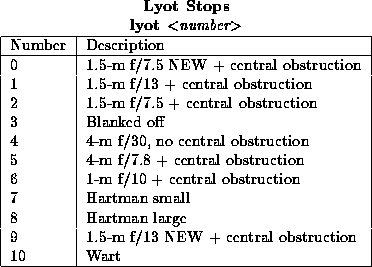When moving CIRIM from one telescope to another or when changing
secondaries at a telescope you must change and align the Lyot stop. To
select the Lyot stop one uses a command of the form ``lyot
n'' where n is the number of the desired Lyot stop (between 0
and 10). A typical command to change a Lyot stop would be lyot 1
to select the 1.5m f/13 lyot stop. Once the stop is selected it must
be aligned with the telescope pupil. This is done by imaging using the
pupil-viewing lens in filter wheel 3. Some pupils are larger than the
field of view of the detector and it will be useful to use jog
f3 to view different parts of the pupil image. For positive offsets
jog f3 moves the viewing window up. 500 motor steps will move
the viewing region about half of the array size. You can then ``jog''
the pupil stop position vertically using the command jog lr
nnn where nnn is the number of motor microsteps. Jogs should
be 50 ![]() n microsteps. Note, when using the jog command
you should not use a + sign infront of positive jogs.
If the motor is powered off it will
presumably settle into the nearest potential minimum making it
impossible to move the stop a fraction of a full motor step. For
positive steps, jog lr moves the stop up on the screen and a
typical step size should be about 200 microsteps.
You can ``jog'' the pupil stop position horizontally using the command
jog lt nnn where nnn is the number of motor
microsteps. For positive steps, jog lt moves the stop to the
right on the screen and a typical step size should be 500 microsteps.
If you end up adjusting the Lyot stop, record the total number of
steps moved in the two axes, since you will need to re-do the fine
adjustments if you initialize the Lyot stop motors. To initialize the
Lyot stop motors use the command lyotinit. lyotinit leaves
the Lyot stop in the 0 position and centered and you will have to repeate
the centering procedure for the Lyot stop. Thus, do not reinitialize
the Lyot stop unless it is absolutely needed. A list of the possible
pupil stops is given below.
n microsteps. Note, when using the jog command
you should not use a + sign infront of positive jogs.
If the motor is powered off it will
presumably settle into the nearest potential minimum making it
impossible to move the stop a fraction of a full motor step. For
positive steps, jog lr moves the stop up on the screen and a
typical step size should be about 200 microsteps.
You can ``jog'' the pupil stop position horizontally using the command
jog lt nnn where nnn is the number of motor
microsteps. For positive steps, jog lt moves the stop to the
right on the screen and a typical step size should be 500 microsteps.
If you end up adjusting the Lyot stop, record the total number of
steps moved in the two axes, since you will need to re-do the fine
adjustments if you initialize the Lyot stop motors. To initialize the
Lyot stop motors use the command lyotinit. lyotinit leaves
the Lyot stop in the 0 position and centered and you will have to repeate
the centering procedure for the Lyot stop. Thus, do not reinitialize
the Lyot stop unless it is absolutely needed. A list of the possible
pupil stops is given below.
